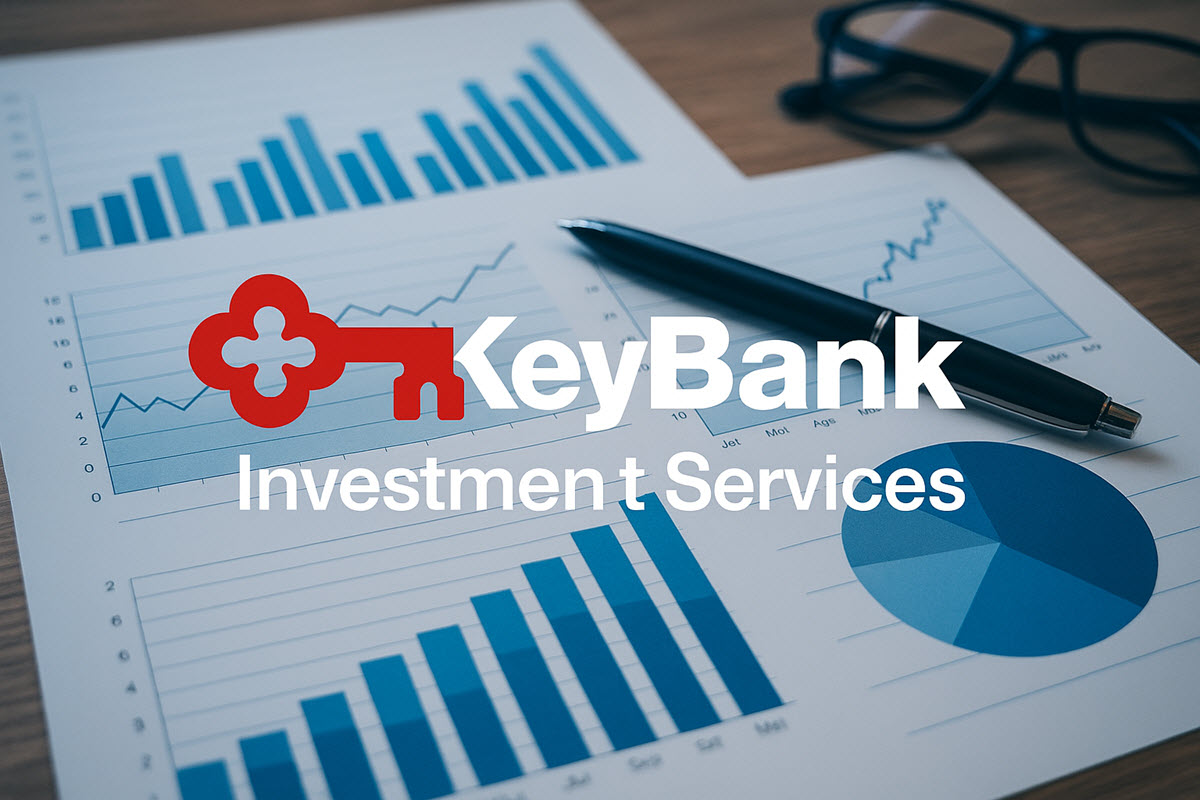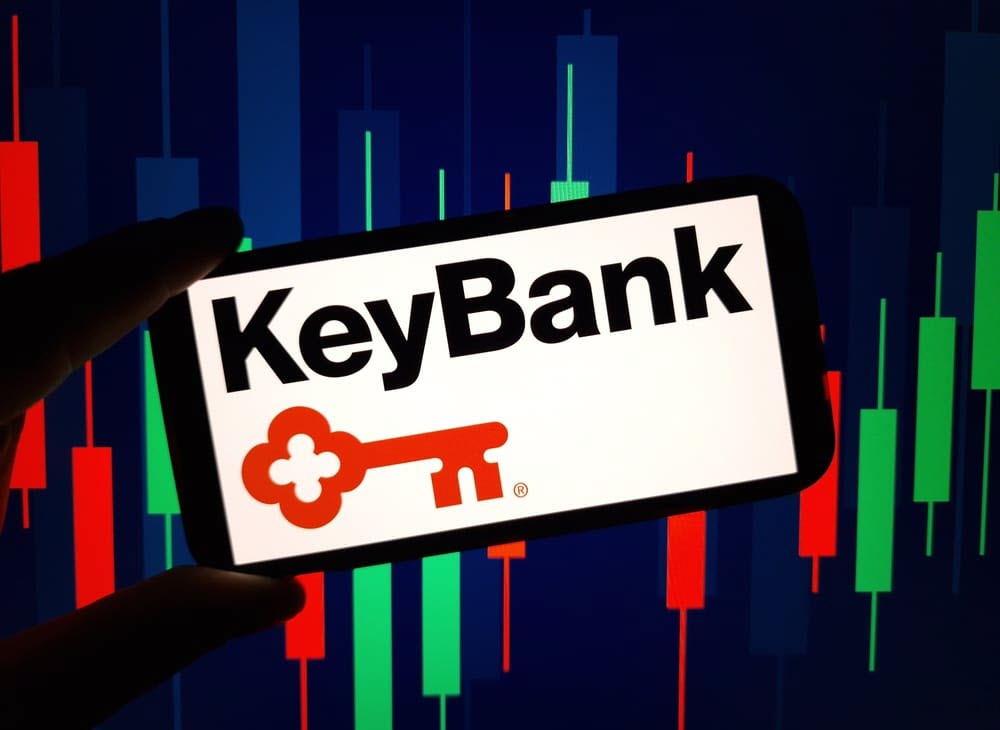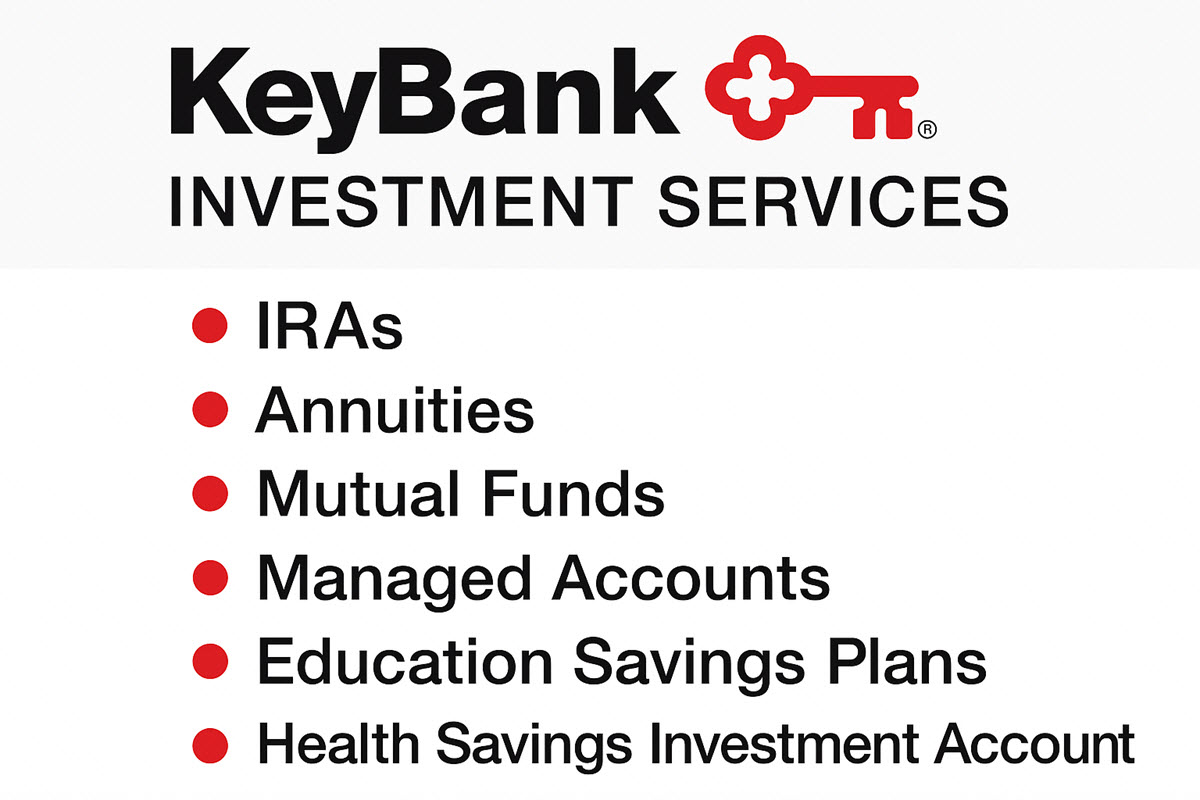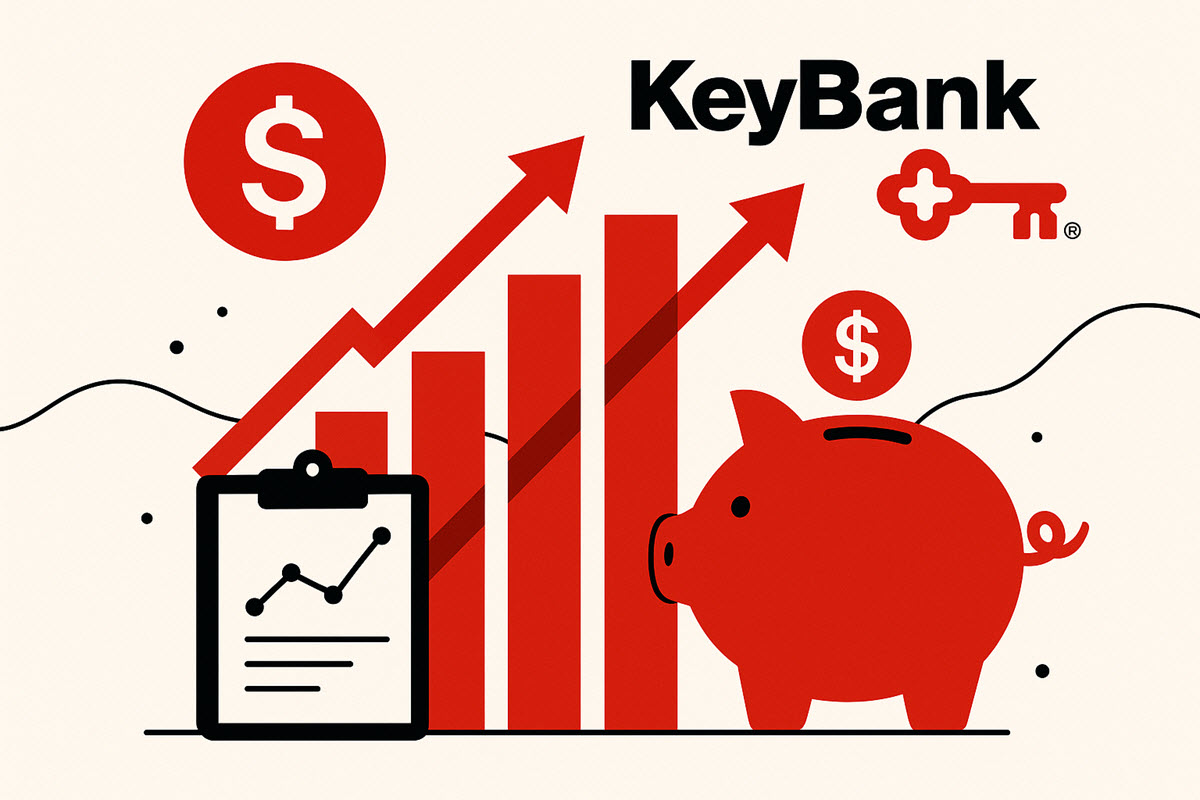KeyBank investment services offer a simple way to start investing without leaving your bank. With flexible options like IRAs, annuities, and managed accounts, you can tailor your plan to fit your goals.

It’s a one-stop solution for people who want both banking and investing in one place. In this review, we will explore all you need to know about KeyBank’s Key Investment Services (KIS) and products before getting started.
Overview of KeyBank Investment Services
All KeyBank investment services are offered through a financial advisor firm named Key Investment Services. It was created in 2005 and operates under KeyCorp, one of the largest bank-based financial services companies in the country. While KeyBank operates over 1,000 branches across 15 states, KIS is its registered broker-dealer and investment advisory arm.
KIS offers access to financial advisors who help clients build personalized investment strategies. The firm manages billions in assets, mostly through traditional portfolios, IRAs, annuities, and mutual funds.
This firm serves a variety of clients, from everyday individuals and families to high-net-worth investors. It also works with retirement plans, nonprofit organizations, trusts, and small businesses, helping them grow and manage their money responsibly.
But there’s a key distinction: Unlike fee-only fiduciaries, KIS advisors may receive commissions based on products sold. That means they can be both advisors and brokers, an important factor to consider.

Core KeyBank Investment Services
KeyBank doesn’t take a one-size-fits-all approach. Instead, it offers multiple services to meet clients where they are in their financial journeys. Let’s break these KeyBank investment services down.
Individual Retirement Accounts (IRAs)
KeyBank offers several types of Individual Retirement Accounts (IRAs):
- Traditional IRA: This type lets you make contributions that might reduce your taxable income. Your investments grow without being taxed until you withdraw the money, usually after age 59½. It’s a smart choice if you expect to be in a lower tax bracket when you retire.
- Roth IRA: With a Roth IRA, you pay taxes on the money you contribute now, but your earnings grow tax-free. When you take money out in retirement, you don’t owe any taxes, and neither do your beneficiaries. There are no required minimum withdrawals, so you can leave your money growing as long as you like.
- Rollover IRA: Ideal for moving funds from a former employer’s 401(k) into an individual account.
You can choose between:
- FDIC-insured IRAs (like CDs and money market accounts for safety)
- Brokerage IRAs with more investment choices, like stocks and mutual funds
What sets KIS apart here is accessibility. You can start contributing with as little as $100/month. That’s great for younger professionals who want to ease into investing.
Their advisors also help you calculate retirement needs and select appropriate asset mixes.
Fixed & Variable Annuities
Annuities are long-term investments that provide guaranteed income in retirement. These are contracts issued by insurance companies and are designed to help you feel more secure about your financial future. KeyBank offers:
- Fixed Annuities: Predictable payouts, not tied to the market
- Variable Annuities: Linked to investments like mutual funds; offer potential for higher growth, but with risk
- Deferred Annuities: Income begins later
- Immediate Annuities: Payouts begin soon after purchase
Annuities can be complex and often come with fees, so it’s worth sitting down with an advisor to understand the long-term impact.
Mutual Funds
KeyBank gives access to a wide range of mutual funds managed by respected institutions. These funds allow investors to pool money with others to purchase a diversified basket of stocks, bonds, or other assets.
Why this matters:
- Diversification reduces risk
- Professional KeyBank investment management means less day-to-day involvement from you
- Low minimum investments make it accessible
There are different types of mutual funds available:
- Open-end funds (most common; not traded on exchanges)
- Closed-end funds (fixed number of shares, traded like stocks)
- Objective-based funds (designed for growth, income, or a balanced mix)
You can choose funds aligned with your risk profile, aggressive growth, moderate, conservative, or ask your advisor to build a fund mix that fits your goals. Before you invest, KIS will provide a prospectus, a document explaining fees, risks, objectives, and past performance. This helps you make smart, informed decisions.
Managed Accounts
If you prefer a more hands-off approach but still want a tailored strategy, managed accounts might suit you.
KeyBank Investment Services offers:
- Model Portfolio Strategy Programs: Diversified portfolios of mutual funds and ETFs, pre-designed by investment experts
- Separately Managed Accounts (SMAs): Customized strategies for higher-net-worth clients
- Unified Managed Accounts (UMAs): Combine multiple investment types into one streamlined portfolio
Advisors monitor your portfolio regularly, rebalance it, and adjust it as your goals or market conditions change.
Education Savings Accounts (529 & Coverdell)
Planning for a child’s college education? KeyBank supports:
- 529 College Savings Plans: Tax-advantaged savings for tuition and educational expenses. This KeyBank investment account is owned by a custodian (like a parent), which can help with financial aid.
- Coverdell ESAs: $2,000 annual contribution limit per child, more flexible in terms of what’s covered, but with lower contribution limits.
These KeyBank investment services can be a smart way to invest while receiving potential state or federal tax benefits. KIS helps families understand their options and structure savings plans accordingly.
Health Savings Investment Accounts (HSA Investing)
If you have a high-deductible health plan (HDHP), you may already be using an HSA to save on taxes and cover medical costs. But with KeyBank and KIS, you can go one step further, invest part of your HSA funds to help your savings grow.
Here’s how it works:
- Once your KeyBank HSA investment account has at least $3,500, you can invest $1,000 on your own in select mutual funds
- With a $7,000 HSA balance, you can work with a KIS advisor to access more options like ETFs and managed portfolios
- You must keep $2,500 (self-managed) or $6,000 (advisor-assisted) in your HSA checking account to stay eligible
Investing through your HSA can boost your retirement savings while still keeping money available for medical expenses.
Investment Planning & Goal Setting
At the heart of KeyBank investment services is a customized financial plan. When you become a client, a financial professional will meet with you to understand your goals, your current financial situation, and where you want to be in the future.
They help you build a step-by-step plan that includes:
- Growing your overall wealth
- Preparing for a comfortable retirement
- Making the most of your retirement income
- Saving for big life events like buying a home
- Planning ahead for your children’s or grandchildren’s college education
- Creating a legacy or passing wealth to the next generation
Your advisor will not only help you build the plan, but they’ll also help you monitor it over time. As your life changes, whether it’s a new job, marriage, or unexpected expense, your plan can be updated to stay on track with your goals.
This personalized approach acts like a financial roadmap. You’ll know what steps to take, when to take them, and how each decision moves you closer to your goals. It’s all about giving you confidence, control, and peace of mind over your financial future.

Fees of KeyBank Investment Services
When it comes to KeyBank investment services, the fees you’ll pay depend on which products or accounts you choose. While the pricing isn’t the lowest on the market, many clients find value in the personalized support from KeyBank’s financial advisors.
Types of Fees
Here’s a breakdown of the typical costs:
- Managed Accounts: These accounts are actively handled by professionals who adjust your investments based on your goals. You’ll usually pay between 1.0% and 3% of the total amount you invest each year. There may also be extra manager fees (around 0.20%).
- Mutual Funds: While these don’t always have upfront charges, they come with built-in management fees, often ranging from 0.5% to 1.5% annually. These fees are deducted from your investment returns.
- Annuities: These are more complex KeyBank investment banking products that can include insurance costs, maintenance fees, and surrender charges (fees for early withdrawal). It’s important to ask your advisor about these before committing.
- IRAs and HSAs: These KeyBank investment services may involve custodial fees, which cover account maintenance, or advisory fees if an advisor is helping manage your investments inside the account.
| Account Type / Service | Minimum Balance | Fee Description | Approx. Fee (% of AUM/year) |
|---|---|---|---|
| Model Portfolio Strategy (wrap fee) | ~$5,000 – $10,000 | Comprehensive advisory, brokerage & administrative platform | 0 – $500K: ~1.80% $1M+: ~1.00% |
| Separately Managed Accounts (SMAs) | Typically ≥ $100,000 | Third-party manager overseen by KIS, tailored portfolio | Up to ~3.0% for the first $500K; scales down |
| Minimum annual wrap fee | — | Applied when asset fees are very low | $130/year minimum |
| Brokerage (per‑trade commissions) | — | Stock trades, mutual funds, bonds, etc. | Varies by trade; mutual fund loads up to ~5–6% |
| Mutual fund ongoing/trail fees | — | Indirect annual fees deducted within each fund | ~0.50% – 1.50% fund expense ratio |
| Administrative & account fees | — | Transfers, wires, statements, and other paperwork | Ranges: $10 – $250 based on service |
While these fees are typically higher than those offered by online robo-advisors or DIY platforms, you’re also getting human guidance and a personalized investment plan, which can make a big difference, especially for beginners or people with more complex financial needs.
What You Should Do
Before using KeyBank investment services, make sure to ask your advisor the following:
- What are the total advisory fees I’ll pay?
- Are there any commissions on products like annuities or insurance?
- What’s the minimum investment amount required to get started?
- Are there any fee discounts if I invest a larger amount?
Understanding these costs upfront will help you avoid surprises and compare your options clearly.

How to Get Started with KeyBank Investment Services
Thinking about using KeyBank investment services? Here’s how to begin:
- Schedule a free meeting with a KeyBank financial advisor. You don’t have to commit to anything, just use this time to ask questions and explore your options. There are three main ways you can do it:
- Call the KIS support team at 1‑888‑547‑2968 to ask questions or schedule a consultation with a licensed advisor.
- Visit Key.com and fill out the investment inquiry form. A representative will be in touch with you to go over your options and what to do next.
- If you like face-to-face interaction, stop by a nearby KeyBank branch. Many branches have in-house financial professionals who can walk you through the process.
- Talk through your goals, whether it’s retirement, education, or growing your wealth, and let the advisor suggest a strategy that fits. You’ll also take a short risk tolerance questionnaire. This helps your advisor understand your comfort level with market fluctuations and recommend a portfolio that fits your goals.
- Ask for a clear breakdown of fees so you know exactly what you’ll be paying and why.
- Review how their investment approach works, including how often they’ll rebalance your portfolio or check in on your progress.
- Review key documents
Before opening your KeyBank investment account, you’ll be asked to review several important disclosures:- Form ADV (details about the advisor and services)
- Fee Schedule (so you know what you’re paying)
- Client Relationship Summary (outlining how KIS works with you)
- Open your investment account
After all documents are signed and approved, your account will be set up. You can then start your KeyBank investment services based on your personalized financial plan.
Getting started is easy, and a simple conversation can help you feel more confident about where your money is going. Once you have a KeyBank investment account, don’t forget to ask your advisor to walk you through digital account tools, so you can monitor your investments online or through the KeyBank mobile app.

Pros and Cons of KeyBank Investment Services
Like any investment firm, KeyBank has strengths and weaknesses. Here’s a snapshot.
Pros of KeyBank investment services:
- Full range of investment options under one roof
- Low starting minimums for IRAs and mutual funds
- Personalized advice from a real human
- Integration with your KeyBank banking accounts
- Option to invest tax-advantaged via IRAs, 529s, HSAs
- Leverage strong model portfolios from trusted third parties like Vanguard and BlackRock.
Cons of KeyBank investment services:
- Higher fees than robo-advisors or self-directed platforms
- Advisors may earn commissions, creating potential bias
- Past compliance issues (minor): FINRA censured KIS in 2016 and 2019.
Smart Tips for Choosing The Right Financial Advisor
Before choosing a financial advisor or investment service like Key Investment Services, it’s important to take a few smart steps to protect your money and make confident decisions:
- Look up your advisor’s background: Use FINRA’s BrokerCheck to check your advisor’s license, past experience, and any complaints or disciplinary actions. This helps you avoid surprises later.
- Ask how your advisor gets paid: Some advisors earn commissions on certain products or may receive bonuses for selling in-house options. It’s acceptable to ask directly if they get paid for recommending this investment.
- Read the fee schedule carefully: Know exactly what you’re paying, especially for account management, trades, or advisory services. If you have a large account, you might be able to negotiate lower fees.
- Compare your options: Don’t just go with the first advisor you meet. Compare KeyBank investment services with low-cost registered investment advisors (RIAs) or robo-advisors, which often charge much lower fees and offer similar services.
- Understand tax impacts: If your portfolio is changed or rebalanced, it could result in capital gains taxes. Some clients online have reported unexpected tax bills after making changes to their KeyBank investment accounts. Always ask, “Will this trigger taxes?”
Doing this due diligence up front can help you avoid costly mistakes and feel more in control of your financial future.

FAQs About KeyBank Investment Services
Is Key Investment Services a fiduciary?
- Yes. Key Investment Services (KIS) acts as a fiduciary when offering advisory accounts, meaning they are legally required to act in your best interest.
How much money do I need to open an investment account with KeyBank?
- Minimum requirements vary. For brokerage IRAs or mutual funds, you can often start with a few hundred dollars. For managed accounts, the minimum may be $5,000 or more.
Does KeyBank offer socially responsible or ESG investments?
- Yes. KIS offers access to ESG (Environmental, Social, and Governance) investment options through select mutual funds and managed portfolios. Ask your advisor for availability.
Can I manage my KeyBank investments online?
- Yes. You can view and manage your investments through KeyBank’s online and mobile banking platform, including balances, transactions, and performance tracking.
Are KeyBank investment services insured by the FDIC?
- No. Investment products offered through Key Investment Services are not FDIC insured, not guaranteed by the bank, and may lose value.
KeyBank investment services aren’t flashy, but they are well-rounded. With experienced advisors, flexible account types, and a focus on long-term planning, KIS offers solid value for clients who want more guidance. As always, you should understand your risk tolerance and choose an investment partner who puts your goals first.
